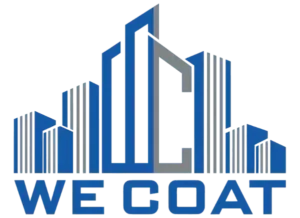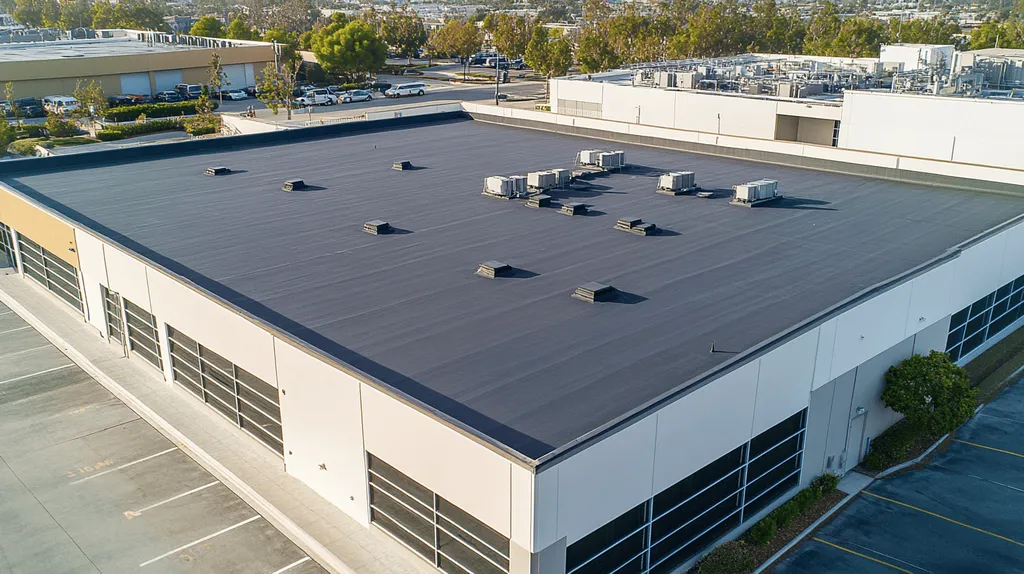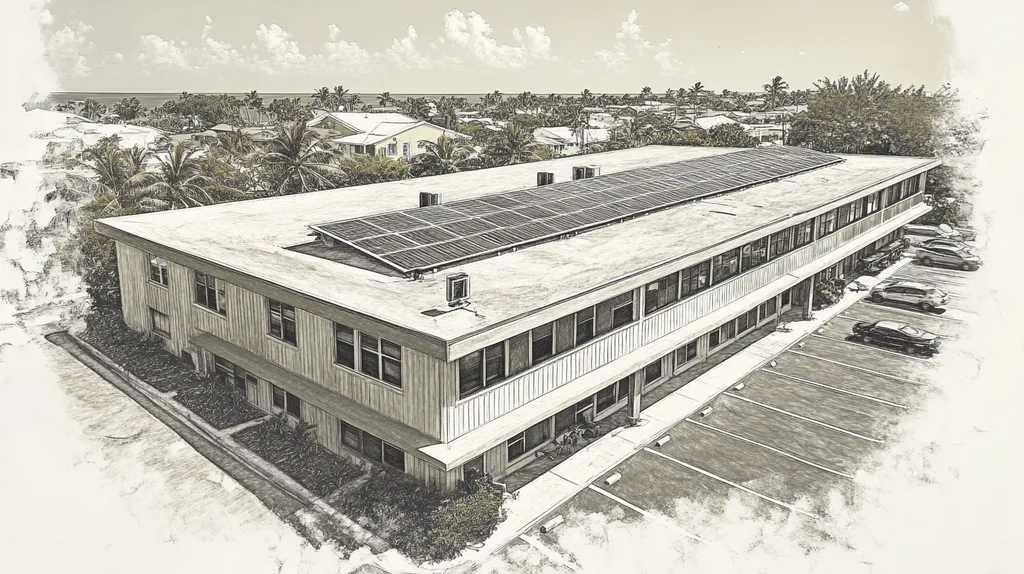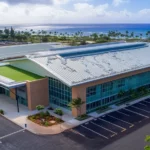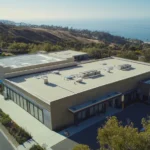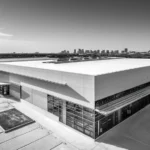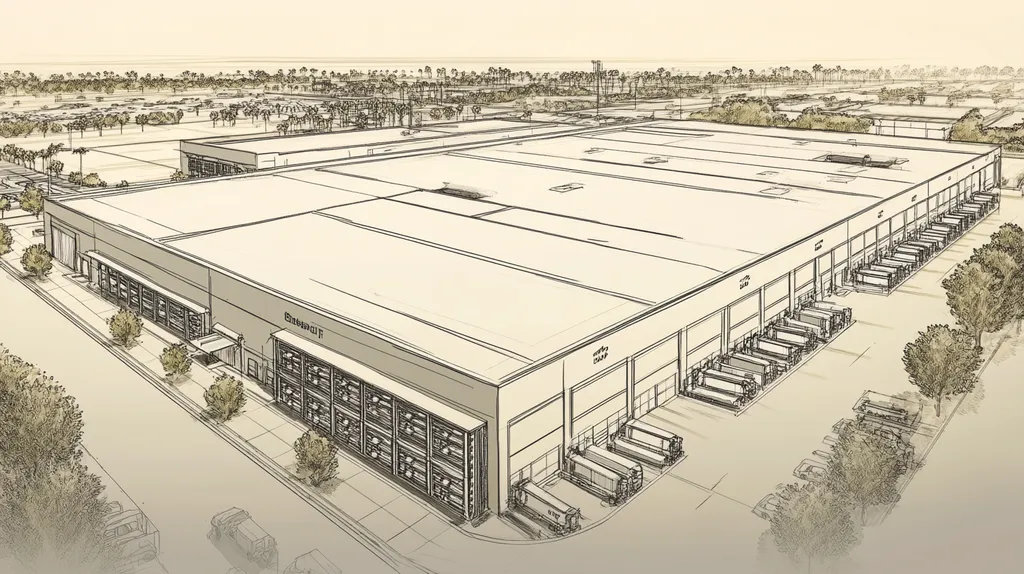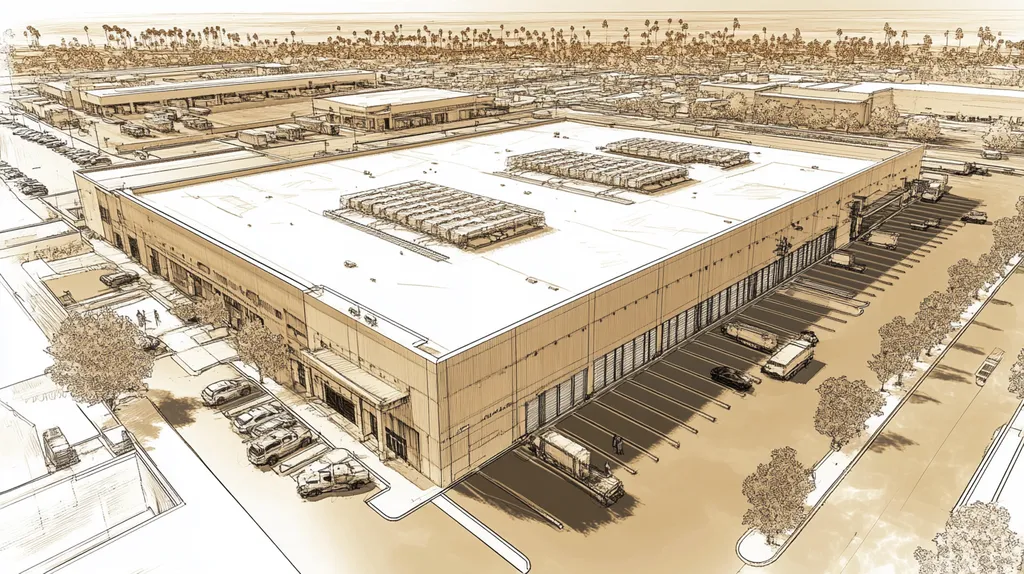The U.S. commercial roofing sector wastes an estimated $3.7 billion annually due to inefficient material choices driven by brand loyalty rather than performance data. Research indicates that up to 40% of a building’s energy loss occurs through poorly optimized roofing systems.
Despite advances in roofing technology, many property owners continue relying on established brands while overlooking innovative solutions that could deliver superior energy efficiency and cost savings.
This analysis examines how brand-centric decision making impacts energy performance, maintenance costs, and long-term sustainability in commercial roofing applications.
SECTION 1: CURRENT PRACTICES
In an era of rising energy expenses, energy efficiency in commercial roofing is more critical than ever. The U.S. Department of Energy reports that buildings are responsible for almost 40% of the nation’s energy consumption. Many property owners miss out on significant cost savings and sustainability benefits by overlooking energy-efficient roofing options. This section examines prevalent roofing materials, standard maintenance practices, and the energy efficiency standards that shape modern commercial roofing.
Common Roofing Materials Used
Commercial roofing encompasses a diverse array of materials, each offering unique energy performance features. Common choices include TPO (Thermoplastic Olefin), EPDM (Ethylene Propylene Diene Monomer), and built-up roofing systems. TPO is particularly valued in warmer climates for its high reflectivity, which can substantially reduce cooling costs.
EPDM is recognized for its strength and flexibility, making it a popular choice among property owners. However, the focus often rests on well-known brands rather than exploring innovative alternatives that might deliver better energy efficiency.
As sustainability becomes increasingly essential, alternative options like green roofs are gaining traction. These systems not only lower energy consumption but also offer benefits such as improved insulation and efficient stormwater management.
By grasping the various roofing materials available, property owners can make informed decisions that balance budget needs with energy efficiency objectives.
Standard Maintenance Practices
To maintain the longevity and performance of commercial roofs, regular upkeep is essential. Unfortunately, many property owners default to a reactive maintenance approach, only addressing issues as they arise. This often results in increased energy loss and costly repairs.
Adopting proactive maintenance strategies is key. This includes routine inspections to assess potential problems such as debris buildup, damaged flashing, and compromised roof membranes that can risk energy efficiency.
Ignoring these maintenance practices can lead to higher operational costs and a shorter lifespan for the roofing system, negating the initial savings achieved through energy-efficient materials.
Implementing a comprehensive maintenance plan not only preserves the roof’s service life but also enhances its energy performance, resulting in significant long-term value.
Energy Efficiency Standards
The framework for energy efficiency in commercial roofing is largely influenced by regulatory standards and industry benchmarks. Organizations such as ENERGY STAR and the Cool Roof Rating Council set the guidelines that roofing materials must meet to be classified as energy-efficient.
These standards facilitate informed decision-making for property owners, helping to minimize energy consumption and decrease environmental footprints. Meeting energy efficiency standards is not merely a regulatory obligation; it presents tangible cost-saving opportunities.
Additionally, numerous states provide incentives for the adoption of energy-efficient roofing solutions, offering financial encouragement for compliance. Property owners unaware of these frameworks risk forgoing considerable savings and competitive advantages.
As the emphasis on sustainability intensifies, adherence to energy efficiency standards is expected to evolve, pressing property owners to stay abreast of developments and adapt their roofing strategies accordingly.
SECTION 2: SYSTEMIC ISSUES
Energy efficiency in commercial roofing is frequently compromised by systemic shortcomings that can result in substantial energy losses. For instance, buildings lacking proper insulation can lose as much as 30% of their energy through the roof alone. This inefficiency not only inflates utility expenses but also undermines sustainability efforts, making it imperative for property owners to confront these underlying challenges. The primary areas requiring focus include inadequate insulation practices, insufficient use of reflective roofing materials, and the oversight of regular roof audits.
Inadequate Insulation Practices
A prevalent issue in commercial roofing is inadequate insulation, which critically impacts energy efficiency. Many properties still rely on outdated insulation methods that do not meet contemporary standards, leading to inflated heating and cooling costs.
Research indicates that proper insulation can cut heating expenses by up to 20%. When this essential factor is overlooked, not only are immediate costs affected, but the long-term sustainability of the building is also compromised. Upgrading insulation must be a primary concern for facilities aiming to lessen their carbon footprint.
Moreover, improper insulation installation can create thermal bridges, areas where heat escapes more easily. This leads to continuous energy loss and discomfort for occupants. Therefore, carefully reviewing and enhancing insulation methods should be a core element of any effective roofing strategy.
Investing in high-quality, correctly installed insulation yields dividends in reduced energy expenses and enhanced building performance. Addressing this systemic issue is essential for property owners dedicated to improving energy efficiency and minimizing operational costs.
Lack of Reflective Roofing Adoption
Despite their significant potential to reduce heat absorption, reflective roofing materials are often underutilized in commercial properties. This oversight can result in rising interior temperatures during summer months, consequently increasing air conditioning requirements.
Studies reveal that reflective roofs can lower surface temperatures by as much as 30 degrees Fahrenheit, a considerable reduction that translates into significant energy savings over time, especially in warmer climates. The failure to adopt reflective materials represents lost opportunities for enhancing energy efficiency.
Additionally, buildings equipped with reflective roofing typically enjoy prolonged roof lifespans. Lesser heat exposure diminishes wear and tear, reducing the frequency of repairs and replacements. Transitioning to reflective roofing should be viewed as a strategic initiative by facility managers aiming to manage energy consumption effectively.
Promoting the adoption of reflective roofing also has broader implications, contributing to the mitigation of urban heat island effects. Thus, investigating advanced roofing options is crucial in today’s eco-conscious landscape.
Neglect of Regular Audits
Regular roof audits are frequently disregarded, yet they serve a vital purpose in maintaining energy efficiency. Without consistent evaluations, issues such as leaks or insulation deficiencies may remain unnoticed, leading to increased costs and diminished performance.
Experts advocate for conducting roofing audits at least twice annually. These evaluations help detect areas in need of improvement, including damaged insulation or ineffective drainage systems. If ignored, minor issues can escalate into major problems that adversely impact energy efficiency.
Furthermore, these audits provide facility managers with updates on the latest energy-saving technologies and materials. Staying informed is critical for making proactive decisions regarding roof maintenance and upgrades. Consistent audits represent an investment in both the property’s lifespan and overall operational performance.
Ultimately, neglecting regular audits can lead to heightened operational costs and decreased roofing efficiency. Prioritizing these assessments fosters a culture of diligence that can translate into significant long-term savings and enhanced property value.
SECTION 3: MISSED OPPORTUNITIES
In the competitive landscape of commercial roofing, many property owners often overlook significant advancements that could dramatically improve energy efficiency and sustainability. Sticking solely to traditional materials and methods can mean missing out on innovative solutions that offer considerable financial savings. For example, research shows that roof coatings can lower energy costs by as much as 30%. Recognizing these missed opportunities can elevate a property’s efficiency and longevity while minimizing environmental impact.
Untapped Potential of Roof Coatings
Roof coatings are a powerful, yet often neglected, solution for enhancing energy efficiency. These products, designed to increase reflectivity, can reduce building temperatures by up to 20 degrees. This cooling effect not only cuts down on air conditioning costs but also extends the lifespan of the roofing system.
Another benefit of roof coatings is that they can often be applied directly over existing roofs, minimizing disruption and waste during installation. This restoration approach can breathe new life into aging roofs and prevent the need for expensive replacements. In some scenarios, using a coating can even enhance warranty coverage, adding further value.
Despite these benefits, many property owners remain unaware of roof coatings or are overly reliant on traditional materials. This oversight prevents them from reaping the rewards of reduced operational costs and improved building performance. Increasing awareness of these options can lead to substantial energy savings.
Ultimately, embracing roof coatings can transform not just individual buildings but also the industry’s approach to sustainable roofing practices.
Overlooking Green Roofing Benefits
Green roofing systems, which integrate vegetation into the roofing structure, operate as natural insulators and can significantly boost energy efficiency. Research has shown that green roofs can reduce heat absorption by up to 80%, leading to notable cooling cost reductions during summer months.
Additionally, green roofs contribute to environmental sustainability through enhanced stormwater management and improved air quality. This positions buildings as part of broader urban sustainability initiatives, attracting eco-conscious tenants and stakeholders.
Currently, many property owners undervalue green roofing due to concerns about upfront costs or perceived maintenance complexity. However, the long-term savings and environmental advantages far outweigh these concerns. Investing in green roofs allows commercial properties to enhance their market appeal while reducing their carbon footprints.
Educating property owners about the benefits of green roofing can shift industry standards toward more sustainable practices, ultimately leading to a greener future.
Ignoring Solar PV Installations
Solar photovoltaic (PV) installations present a significant, yet often overlooked, opportunity for energy savings in commercial roofs. By harnessing the sun’s energy, businesses can considerably reduce their reliance on grid electricity, resulting in lower utility bills. Properties equipped with solar technology have reported energy cost reductions of up to 50%.
Moreover, integrating roofing systems with solar installations can create multiple benefits. Modern roofing materials are designed to support solar panels, improving durability and energy efficiency while facilitating a streamlined installation process that maximizes the roof’s value.
Despite these clear advantages, property owners frequently hesitate to explore solar solutions due to misconceptions about return on investment or concerns over long payback periods. Engaging knowledgeable contractors can help owners understand the various financing options and incentives available. These educational conversations are crucial for transitioning from conventional practices to adopting renewable energy solutions.
Ultimately, integrating solar PV installations can pave the way for a more sustainable future in commercial roofing.
SECTION 4: ROOT CAUSES
The urgency of adopting energy-efficient roofing solutions cannot be overstated; they are essential for both reducing operational costs and mitigating environmental impact. However, many commercial property owners succumb to misinformed material choices driven by brand loyalty instead of assessing actual performance. Furthermore, a lack of understanding regarding local climate conditions and constraints of short-term budgeting exacerbate these poor decisions. These root causes form significant barriers to achieving optimal energy efficiency in commercial roofing.
Misinformed Material Choices
Property owners frequently choose roofing materials based on brand familiarity rather than the specific energy performance of the products. This dependency on established names often overlooks innovative alternatives that provide better insulation and reflective capabilities. For example, a widely recognized membrane might be selected even though cutting-edge materials could outperform it.
Selecting roofing materials without thorough evaluation can lead to increased energy bills and elevated maintenance costs. A roof that fails to meet energy efficiency standards may absorb excessive heat, raising cooling costs during hotter months. Such oversight underscores the need for property managers to prioritize performance metrics over brand reputation.
Furthermore, misconceptions regarding warranty periods can deter decision-makers from exploring newer brands. Many believe that a longer warranty guarantees superior quality, but this is not universally true. Overruling performance in favor of brand trust can undermine the overall value of a roofing investment.
Ultimately, making informed material choices requires diligent research and comparison of the various materials available on the market. This shift in perspective can lead to substantial savings and improved energy efficiency, aligning with broader sustainability objectives.
Inadequate Climate Considerations
A critical oversight in roof selection is the failure to consider local climate conditions. Each region presents unique weather challenges—such as high humidity, extreme heat, or heavy snowfall—that can render even top-rated roofing materials ineffective.
For instance, a reflective roof that performs admirably in sunny climates may falter in regions with frequent rainfall or snow. Poor moisture management can expedite roof deterioration, escalate energy requirements, and result in costly repairs. Each climatic zone has specific requirements that roofing materials must meet to ensure optimal energy efficiency.
Property owners often overlook the importance of ventilation in energy savings. Proper ventilation helps regulate internal temperatures, reducing the load on HVAC systems. Selecting a roof without thorough climate analysis can conflict with ventilation needs, compromising overall performance.
To mitigate these risks, choices should be guided by comprehensive climate assessments. Aligning roofing materials with local conditions will facilitate long-lasting energy savings and enhance roof performance.
Budget Constraints and Short-Term Thinking
Budget limitations play a significant role in decision-making, prompting facility managers to prioritize immediate savings over long-term energy efficiency. While initial costs are undoubtedly important, focusing solely on upfront pricing can result in choosing inferior materials that ultimately lead to higher operational costs.
For instance, opting for a lower-cost roofing system may appear appealing initially but can result in a higher total cost of ownership due to increased energy expenses and frequent repairs. This strategy not only undermines long-term financial planning but also detracts from sustainability goals.
Moreover, a short-term mindset can stifle advancements in roofing technology. Investing in energy-efficient solutions may seem daunting, yet the potential return on investment often outweighs initial outlays. As energy prices rise and regulations tighten, the cost of inaction could eclipse any perceived savings.
A transition towards long-term budgeting and strategic planning can open doors for investments that emphasize sustainability. By evaluating total lifecycle costs, property owners can make decisions that enhance energy efficiency and significantly reduce overall expenses.
DATA DRIVEN EVIDENCE
The demand for energy-efficient commercial roofing has never been more urgent. With buildings accounting for nearly 40% of total energy consumption in the United States, property owners must prioritize energy-saving roofs. Rising energy costs further emphasize the need for innovative roofing solutions that cut operational expenses while enhancing sustainability.
Energy Use Intensities (EUIs) Analysis
Energy Use Intensity (EUI) is a crucial measurement for evaluating a building’s energy performance. It quantifies energy consumption per square foot annually, making comparisons between different buildings straightforward. Analysis of EUIs indicates that traditional roofing materials can significantly increase energy usage.
Recent studies show that buildings equipped with reflective and insulating roofing systems can lower their EUIs by 30% or more compared to conventional materials. This reduction not only results in lower utility bills but also lessens the burden on local energy grids.
By opting for energy-efficient roofing options, facilities can substantially enhance their performance. This shift is particularly vital given the increasing costs of energy and the pressing need to minimize carbon footprints.
Leveraging EUI metrics in decision-making empowers property owners to select roofing systems that are in line with their energy-saving objectives. Understanding EUI can significantly impact facilities aiming for improved efficiency and sustainability.
Cost Savings from Energy-Efficient Roofs
The financial benefits of energy-efficient roofs are both significant and measurable. Research indicates that property owners can anticipate a return on investment (ROI) of up to 20% over the lifespan of energy-efficient roofing systems, which is driven by lower energy bills and available tax incentives.
Energy-efficient roofs often incur fewer repair and maintenance costs over time. For instance, reflective roofing reduces heat absorption, leading to decreased wear and tear and, consequently, long-term savings.
Many municipalities also provide rebates and incentives for the installation of energy-efficient systems. These financial advantages not only foster immediate savings but also promote environmentally responsible roofing choices.
Investing in energy-efficient roofing is a strategic financial move. As energy prices continue to rise, these roofs act as a buffer, shielding facilities from fluctuating costs and ensuring long-term financial vitality.
Case Studies on Net-Zero Buildings
Case studies of net-zero buildings present compelling evidence for the effectiveness of energy-efficient roofing. These buildings produce as much energy as they consume, showcasing the benefits of integrated energy strategies. A prominent example is the Bullitt Center in Seattle, which features a high-performance reflective roof pivotal to its net-zero energy achievement.
Such buildings illustrate how energy-efficient roofs contribute to significant sustainability goals. The design of the Bullitt Center has inspired numerous projects to consider similar roofing materials, highlighting a trend towards smarter building decisions.
Moreover, energy data from net-zero buildings reveal that these advancements can reduce operational costs while boosting occupant comfort. The evidence consistently underscores that energy-efficient roofing plays a central role in reaching net-zero status.
In conclusion, insights from net-zero buildings strengthen the case for energy efficiency in commercial roofing. As more facilities adopt these lessons, the industry moves closer to a collective commitment to sustainability and energy conservation.
SECTION 6: ALTERNATIVE SOLUTIONS
As energy costs continue to escalate and environmental concerns grow more pressing, the need for effective roofing solutions becomes critical. Property owners and facilities managers are increasingly under pressure to adopt strategies that maximize energy efficiency. The cool roof market, projected to reach $12.4 billion by 2027, underscores the demand for innovative solutions that challenge traditional brand loyalties while delivering measurable energy savings. This section delves into viable alternatives that can lead to significant improvements in performance and sustainability.
Implementing Cool Roof Technologies
Cool roof technologies are emerging as a powerful solution for reducing energy consumption. These systems are designed to reflect more sunlight and absorb less heat compared to traditional roofing materials, resulting in lower cooling costs. For instance, a white or light-colored roof can reduce surface temperatures by up to 50°F compared to darker options, leading to substantial energy efficiency gains.
Utilizing cool roofing materials can yield energy savings of 10-15% during peak summer months. This not only decreases utility expenses but also prolongs the lifespan of roofing materials by minimizing heat stress. As municipalities increasingly mandate the implementation of cool roofs to combat urban heat islands, their relevance in modern roofing strategies becomes even more vital.
Additionally, cool roofs contribute to enhanced indoor comfort and decreased greenhouse gas emissions. Property owners who embrace these technologies often experience quicker returns on investment through lowered energy rates and elevated building values. By choosing cool roofing options, businesses can maintain a competitive edge in a rapidly evolving energy landscape.
Integrating Renewable Energy Systems
Integrating renewable energy systems, such as solar panels, can significantly enhance the energy efficiency of commercial roofs. By harnessing solar energy, businesses can drastically reduce their dependence on costly grid electricity, with research indicating potential savings of up to 50% on energy costs over time.
Furthermore, placing solar panels on rooftops makes efficient use of existing space, allowing buildings to enjoy dual functionality without demanding additional land. Currently, around 1.5 million commercial buildings across the U.S. are exploring solar options, signifying a notable shift towards sustainable practices.
Investing in renewable energy not only trims operational costs but also elevates a property’s marketability. Buildings equipped with renewable energy systems may qualify for various tax incentives and grants, further enhancing their financial feasibility. By prioritizing renewable energy, property owners can position themselves as frontrunners in energy efficiency and sustainability.
Optimized Roof Design and Materials
Optimized roof design and material selection are essential for bolstering energy efficiency in commercial buildings. Innovative designs that integrate insulation, ventilation, and reflective coatings can significantly reduce energy loss. Well-designed roofs have the potential to lower energy needs by 20-30%, creating a meaningful impact on overall building performance.
For example, utilizing advanced insulation materials can minimize heat transfer, maintaining comfortable indoor temperatures regardless of external weather conditions. Moreover, selecting materials that reflect solar radiation can further decrease cooling demands, supporting overall energy efficiency measures.
Collaborating with experienced roofing professionals during the design phase enables property owners to identify tailored solutions that effectively meet their specific needs. By focusing on roof optimization, businesses not only achieve energy savings but also enhance the durability and functionality of their roofing systems.
The Bottom Line
The commercial roofing industry’s overreliance on established brands costs property owners an estimated $3.7 billion annually in unnecessary energy expenses.
Modern alternatives to traditional roofing systems consistently demonstrate 20-30% greater energy efficiency, yet brand loyalty continues to impede widespread adoption of these innovative solutions.
As energy costs rise and environmental regulations tighten, property owners can no longer afford to prioritize familiar brands over proven performance metrics.
The data clearly shows that breaking free from brand-centric decision making in favor of evidence-based material selection could reduce building energy consumption by up to 40% while extending roof lifespans by 5-10 years.
The future of commercial roofing lies not with established brands, but with solutions that deliver measurable energy efficiency and sustainable performance.
FREQUENTLY ASKED QUESTIONS
Q. How do current practices affect commercial roof energy efficiency?
A. Current practices in commercial roofing often neglect innovative materials that enhance energy efficiency. Many property owners prioritize established brands rather than exploring alternatives like green roofs or reflective systems. This oversight can lead to higher energy costs and shorter roof lifespans due to inadequate maintenance and outdated materials.
Q. What systemic issues affect industrial roof energy efficiency?
A. Systemic issues like inadequate insulation and lack of reflective materials significantly compromise energy efficiency in industrial roofing. Property owners often overlook the importance of regular audits, which leads to unnoticed issues like leaks or thermal bridges. Addressing these challenges is vital for reducing energy losses and operational costs.
Q. What missed opportunities can impact commercial roof energy efficiency?
A. Opportunities like roof coatings, green roofing systems, and solar PV installations are often overlooked. These innovations can significantly reduce energy costs and enhance sustainability. Property owners sticking to traditional methods miss out on substantial financial savings and environmental benefits associated with modern roofing solutions.
Q. How do root causes affect decisions on commercial roofs?
A. Root causes such as brand loyalty and inadequate climate considerations heavily influence material choices. Many property owners choose familiar brands over evaluating performance metrics. Additionally, budget constraints can lead to short-term decisions that ultimately increase long-term operational costs and hinder energy efficiency.
Q. What data-driven evidence supports energy-efficient commercial roofs?
A. Data reveals that energy-efficient roofs can reduce energy use intensity by 30% or more. Studies show significant cost savings in properties prioritizing innovative roofing solutions, backed by tax incentives. Evaluating energy performance through metrics such as Energy Use Intensity helps property owners align roofing decisions with sustainability goals.
Q. What alternative solutions improve commercial roof energy efficiency?
A. Implementing cool roof technologies, integrating renewable energy systems, and optimizing roof designs can significantly enhance energy efficiency. Cool roofs reflect sunlight, while solar installations can reduce reliance on grid electricity. Focusing on innovative designs and materials promotes sustainability and long-term savings in commercial roofing.
Q. How can regular maintenance enhance the performance of a commercial roof?
A. Regular maintenance, including inspections and proactive repairs, is crucial for commercial roofs. Implementing a comprehensive maintenance plan can identify potential issues early, preserve energy efficiency, and extend the roof’s service life. Neglecting maintenance often results in significant energy losses and increased operational costs over time.
